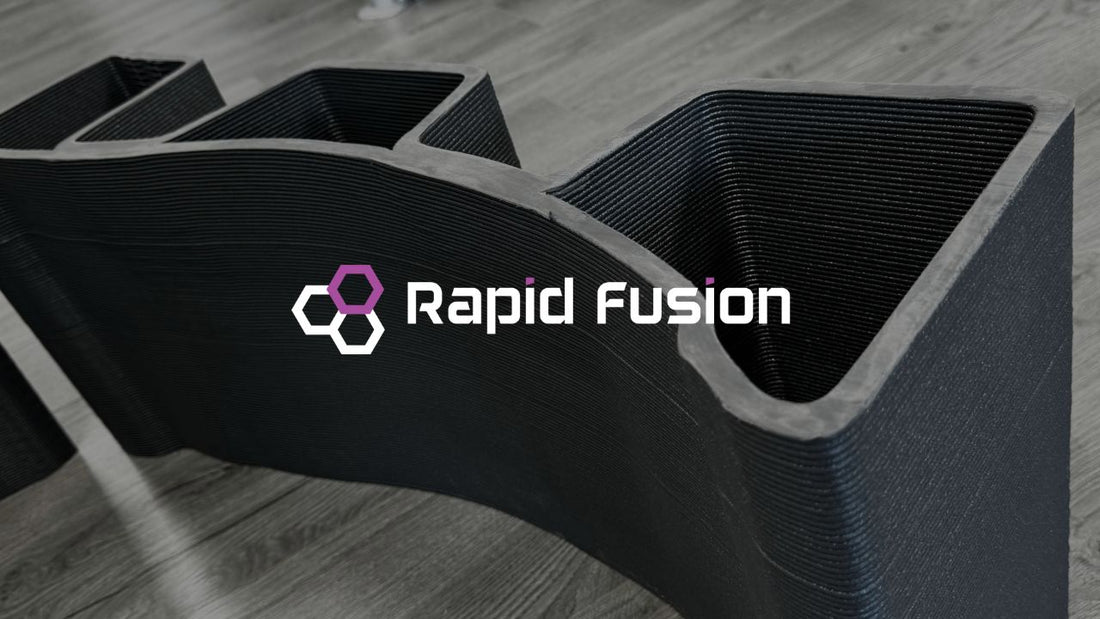Revolutionising 3D Printing with Real-Time Speed and Throughput Synchronisation

Revolutionising 3D Printing with Real-Time Speed and Throughput Synchronisation
At Rapid Fusion, our mission is to push the boundaries of additive manufacturing through innovation and advanced technology. One of our latest breakthroughs is the implementation of a real-time speed and throughput synchronisation algorithm, developed in collaboration with our software partner, Adaxis. This cutting-edge feature dramatically enhances the performance of our PE320 Pellet Extruder, integrating seamlessly with the KUKA robot system.
The Importance of Synchronisation in 3D Printing
In the realm of 3D printing, precision and consistency are paramount. The ability to control the extrusion rate in perfect harmony with the robot’s movement is crucial to achieving high-quality prints. Traditional systems often struggle with synchronisation, leading to issues such as uneven layer widths, oozing, and stringing, particularly during speed changes or intricate manoeuvres.
Our Breakthrough: Real-Time Synchronisation
To address these challenges, Rapid Fusion and Adaxis have developed a sophisticated algorithm that synchronises the robot's speed and the extruder’s throughput in real-time. Here’s a closer look at how this innovation works:
-
Dynamic Adjustment: The algorithm dynamically adjusts the extrusion rate based on the robot’s speed. When the KUKA robot slows down, such as when navigating sharp corners, the extrusion rate is scaled to match the reduced speed, ensuring consistent layer width and eliminating issues like oozing and stringing.
-
Seamless Integration: Leveraging the ADAONE software from Adaxis, the algorithm integrates seamlessly with our PE320 Pellet Extruder and the KUKA robot system. This integration allows for real-time data exchange and adjustments, maintaining optimal performance throughout the printing process.
-
Enhanced Control via Touch Pendant: Operators can adjust the robot’s speed using the touch pendant, and the extrusion rate will be recalculated in real-time to align with the new speed. This feature provides unprecedented control and flexibility, allowing for on-the-fly adjustments without compromising print quality.
-
Preventing Thermal Buildup Issues: The ability to slow down the print on the fly is a game-changer. If a print is at risk of failing due to thermal buildup, or if it looks like it might not support its own weight, operators can reduce the speed to manage the thermal load effectively. This prevents print failures and saves time and material by avoiding the need to start over.
Real-World Applications and Benefits
The implementation of this real-time synchronisation has yielded remarkable results in various applications. For example:
- Consistent Layer Widths: Regardless of speed changes or complex geometries, the extrusion rate remains perfectly synchronised with the robot’s movements, ensuring consistent layer widths and superior print quality.
- Precision in Sharp Corners: The algorithm excels in handling sharp corners, where traditional systems often falter. By scaling the extrusion rate to match the robot’s slower speed, the risk of over-extrusion is eliminated, resulting in cleaner, more precise prints.
- Efficiency and Speed: The ability to make real-time adjustments means that print jobs can be completed faster without sacrificing quality. This efficiency is particularly beneficial for large-scale projects and serial production.
- Thermal Management: On-the-fly speed adjustments enable better thermal management during the printing process. This feature is critical for preventing thermal buildup issues and ensuring that prints do not fail due to inadequate support from previous layers.
Conclusion
The development of our real-time speed and throughput synchronisation algorithm marks a significant advancement in the field of additive manufacturing. This innovation not only enhances the capabilities of our PE320 Pellet Extruder but also sets a new standard for precision and efficiency in 3D printing.
We are proud of our collaboration with Adaxis and the powerful integration of their ADAONE software with our technology. Together, we are driving forward the future of manufacturing, delivering solutions that combine cutting-edge technology with practical, real-world benefits.
Stay tuned for more updates and insights as we continue to explore new frontiers in additive manufacturing!
